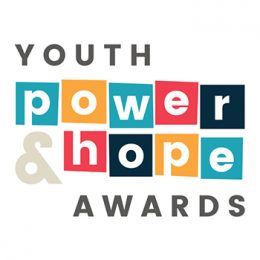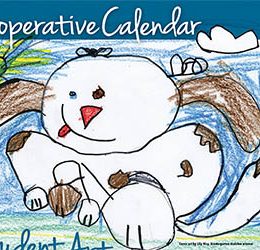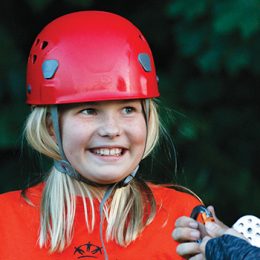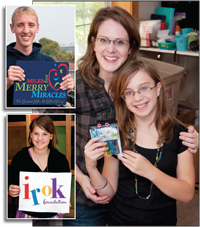 The late radio broadcaster Paul Harvey used to tell us “the rest of the story.” This month, we present our own version of that idea with follow-ups on three youth recently featured in Electric Consumer.
The late radio broadcaster Paul Harvey used to tell us “the rest of the story.” This month, we present our own version of that idea with follow-ups on three youth recently featured in Electric Consumer.
Nick Hebert, Heidi Ziebarth and Kori Brown were introduced to readers through their involvement in the Electric Cooperative Youth Tour to Washington, D.C., our annual Student Art Contest and our inaugural Youth Power & Hope Awards last year. But each has an inspiring postscript we’d like to share. The three are doing extraordinary things giving back to his or her community. The trio offer examples of charity, hope and love. (Click on their names to link to the earlier stories.)
Here is the rest of this trilogy of stories we didn’t get to include the first time we introduced you to them because we simply didn’t have room or because their special project hadn’t yet found its wings. Heidi’s special project actually came about because of her award in our student art contest we told you about in May.
To meet more inspiring Indiana youth, please stay tuned to Electric Consumer. Next month, we’ll introduce you to five more youth working to make their communities better when we present the winners of the 2010 Youth Power & Hope Awards.
Stories and photos by Richard G. Biever
Nick Hebert, Floyds Knobs
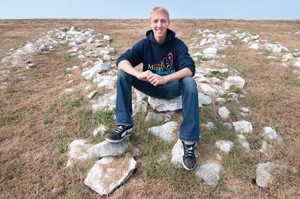
Nick Hebert is the keystone of Miles for Merry Miracles, a community walk/run that provides Christmas to disadvantaged families in the Floyd County area. He started the event in 2008 as his Eagle Scout project. This year’s run is at New Albany’s riverfront amphitheater. The “M” he is sitting on is from the park’s giant “WELCOME” sign.
Angels fly on Eagle’s wings
When the angels start descending from the Angel Tree at the annual Miles for Merry Miracles community run/walk on New Albany’s riverfront Dec. 4, they will be carried on the wings of an eagle — Eagle Scout Nick Hebert.
The 5-kilometer event to bring Christmas cheer to disadvantaged families, now in its third year, began as Nick’s Eagle Scout project when he was a high school sophomore in 2008.
The unique twist for the event is that the entry fee for each participant is the sponsorship of an angel from the tree. The angels, provided by the Salvation Army, are children and their families in the area. That’s a commitment of $50 to $75 to purchase shoes, clothes and toys.
Some 250 to 300 runners and walkers are anticipated this year. In just three years, the event has come an incredible distance from Nick’s fledgling thoughts of what he could do to earn that Eagle rank. “I can remember the moment very distinctly,” he said. “I was just sitting on my couch trying to figure out … how to get this, and how do I get it fast and without pain.”
A lot was riding on the success of the project. His parents wouldn’t let him get his driver’s license until he achieved the Eagle Scout rank, the highest rank attainable in Boy Scouts. It requires the Scout develop a community service project.
“Then I realized this is my last opportunity in Scouts to really give back,” he said.
The idea he came up with was for a race where people could help kids during Christmastime. Nick, a cross country runner at Floyd Central High School, said, “I love running; I can use running to help other people.”
There were some unforeseen hurdles, though, Nick encountered when trying to find the kids and families needing help because of privacy issues. “I was shot down by a couple of organizations at first, and then I happened to call Angel Tree one day,” he said. “They were like, ‘Please, take our angels, please, we need so much help this year.’”
That was the autumn the bottom dropped out of the economy.
“We always see the Angel Tree out in the malls and out in the shops,” Nick said. “And we all see the angels that are left on those trees. And we all wonder how we can help and how we can make a difference.”
The first year, only 15 runners showed up. But Nick said the temperature was 15 degrees and it was sleeting. Still, $8,000 in presents and donations was raised. Last year, 60 runners, participating under beautiful conditions, raised over $17,000 in presents and donations and helped over 200 more children.
Participants aren’t expected to raise all the money themselves. “Runners are actually encouraged to go out to their friends, their families and their communities to get others involved,” Nick said. “It’s not all about that ability to write a check or give a certain amount. It’s also about involving others and getting the whole community involved in this.”
After the run, Nick notes the real highlight is bringing the participants and the angel families together for a Christmas celebration with turkey, ham and all the fixings. The event has been held between the run and Christmas at Nick’s church, the Church of Jesus Christ of Latter-Day Saints, which also chartered his Boy Scout troop.
Here, the angel gifts are delivered to the parents of the children.
“If anybody is to be in the Miles for Merry Miracles, they better be at the Christmas dinner because it brings it all together,” Nick added. “You see all of your efforts really come to life. It becomes more than a name. It becomes a face of the kid that you’ve helped. It really becomes more of a personal aspect, and it touches you very strongly.”
After the first year, Nick said he knew to keep it as an ongoing community event, he’d need help. He credits his mom with much of the success. She designed the logo and helped with promotional materials. He also turned to friends, classmates and students at other area high schools.
Now the event is led by a group of five teenagers from several high schools in the area and supervised by an adult board of directors. A method of succession for the graduating students has been put in place to ensure the student leadership of the event continues.
“I really felt like it was my responsibility to keep it going,” Nick said. “One of the basic principles that we started Miles for Merry Miracles with was the idea that poverty never ends, misfortune never stops, and neither should we.”
He points out to those following in his Nikes, “Even though you might be a small teenager in Southern Indiana, you can still have an impact in some way.”
Now a senior, Nick is looking forward to graduation. He then plans to fulfill a two-year mission of service to his church before attending Brigham Young University in Utah. Nick was a member of the Electric Cooperative Youth Tour to Washington, D.C., in June and was selected to represent Indiana on the Youth Leadership Council. Sponsored by Harrison REMC, which provides electricity to his family’s Floyds Knobs home, Nick also became the first Indiana representative to be named runner-up for the right to deliver an address at the National Rural Electric Cooperative Association’s annual meeting. With the runner-up honor, he’ll be offering an invocation at the national annual meeting in Orlando this coming March.
After college, he sees a career for himself in the non-profit sector in management or law. “I toggled between wanting to be in politics and wanting to be in non-profit,” he said. “I realized that politicians talk about people’s problems, but non-profit people do things about people’s problems.”
And while his high school diploma and university degree are milestones still ahead, Nick said the one he earned creating Merry Miracles will mean the most. “Scouting taught me knots, and it taught me how to camp, and it taught me how to do all those outdoors skills. But more importantly, it taught me how to care for people and care for the community, and how to be a leader in this serving way. That was the most influential thing that Scouts taught me. You can’t replace the importance of that.”
Miles for Merry Miracles

What: A 5-kilometer community fun run/walk, sponsored by a group of Floyd and Clark county teens, that supports the Salvation Army’s Angel Tree Program.
When: 10 am, Dec. 4.
Where: New Albany’s Amphitheater, Waterfront
Fee: Sponsoring an Angel Tree Child.
To register or find more information:
www.merrymiracles.org.
Heidi Ziebarth, Warsaw

Heidi Ziebarth, left, helps students, Lauren Housel, Samhitha Batta and Graham Criss (from left), in Katie Maile’s third grade class at Harrison Elementary in Warsaw peel the labels from broken blue crayons. Students are helping collect and sort crayons in the multi-stage recycling and melting process that produces new novelty crayons Heidi calls “Africrans by Amerikids.” A portion of the proceeds from sales helps orphans in Ghana, Africa.
Coloring the world with hope
Even before Heidi Ziebarth finished a mosaic of a parakeet for the annual Cooperative Calendar of Student Art Contest last March, she had designs on what she’d do with some of the prize money.
“I wanted to do something for Africa,” she said, “but the most I thought I’d get was probably the $50 for honorable mention.”
When she ended up winning $300 as the Fifth Grade Division winner and Artist of the Year, those designs grew. Suddenly her creative artwork became the catalyst for a hands-on project that would melt together lessons in math, chemistry, social studies, history, geography and economics along with a quarter ton of crayons, and involve not just Heidi and her family, but her friends, classmates, community and even orphaned children in Africa.
Her mom, Christi, an artist, encouraged Heidi to do more than make just a donation. “She’s a hands-on learner. I thought, ‘what can we do hands-on ourselves to involve her?’”
A family friend, Jenny Flowers, who encouraged Heidi when she was creating the winning artwork, was about to begin mission work as an art instructor at the Village of Hope Orphanage in Ghana, a country on the Atlantic Ocean in western Africa. Part of her mission was to provide $300 in art supplies to the orphanage. Heidi and her mom decided to help Jenny meet the requirement by supplying homemade crayons.
Christi, a former art teacher, used to recycle old broken crayons by melting them down and reforming them in muffin tins to create crayon “pucks.” Heidi invested some of her prize money to purchase kitchen gadgets that would help with what became known as “The Great Crayon Melt.”
Soon, Heidi’s school, Harrison Elementary, and five other elementary schools in Warsaw were helping Heidi collect old, broken crayons.
The schools collected over 400 pounds of crayons. Kosciusko County Recycling Depot heard about the project and collected a hundred pounds more.
The Ziebarth basement was turned into a crayon factory with assembly-line precision. Crayons had to be sorted, peeled, broken, then melted down and reformed in rectangular molds Christi found at a thrift store.
The new crayons that are created are marbled with flecks of many colors. But, almost immediately, a fly was found in the mixture. “The idea was to make crayons for the children in Ghana,” said Christi. “Then we realized the unpredictable logistics of international mailing, African heat and bumpy transport. It would have cost $200 even to send them with Jenny on the plane.”
By that time, the community had already gotten on board and was collecting old crayons. When people saw the new crayons, the idea shifted again. “These are beautiful,” people would tell them of the colorful sticks they produced. “You need to sell them, and then you could give the money to the orphans.”
“That just seemed like a win-win situation all around,” said Christi.
The one-of-a-kind crayons were then packaged in groups of five, and sold for $5 as “Africrans by Amerikids,” a name Heidi and her mom brainstormed together one night to encompass the cause. Because most of the materials needed are recycled or repurposed, half of the proceeds go to provide care and purchase art supplies for the Village of Hope Orphanage.
Since the project began last spring, Heidi and Christi estimate they’ve distributed or sold 500 packages and have several additional orders of 100-plus packs.
Heidi has put together PowerPoint programs to highlight the project which included crayon history and trivia that she’s presented to schools. She has also been invited to speak and present at several adult educational events at Grace College in nearby Winona Lake where her dad, Tim, is the director of alumni services and teaches finance.
This fall, Heidi and Christi were invited to speak at the Not For Sale Conference in Indianapolis that discussed the shocking, yet relatively unknown, slave and child-labor trafficking around the world. Heidi spoke about her project, and Christi shared her series of paintings on the issue.
At the Village of Hope Orphanage, 21 children formerly lived in slavery at nearby Lake Volta in Ghana. Exposed to this harsh reality, Heidi expresses anger that history book authors and so much of society seem to overlook that slavery in many forms still exists. She wants to help.
“The cause is really big. There’s a lot out there,” said Christi. “But we have a friend named Jenny. She knows 21 children who have been rescued. We can help them. So it’s finding a personal connection that just adds meaning exponentially.”
That connection has continued into the community. “The children’s response to this project has exceeded my expectations,” said Christi. “Children often feel like they don’t have much to give, they don’t have much to offer, but helping with this project is something to offer.”
She added, “On several different levels children can give back. They can give their broken crayons, and they can also give of their time. Because we have help in the system we have set up, it provides them the opportunity to give back and feel like they’re contributing and feel like they’re helping.
“Because Heidi is involved, children are involved,” she added, “it’s very inspiring to kids because they start thinking about what can they do to help some cause or some need in the world. It’s something they can all participate in.”
Heidi tells the kids each color shines brighter and becomes more beautiful when in a pack with the other colors. “Kind of like all of us; we are great as individuals but … we are able to accomplish more when we work together as a team, cooperating and aiming toward a similar goal.”
Heidi says they melt all the crayons together, and what comes out is much more beautiful than the old broken crayons ever were alone.
Africrans by Amerikids
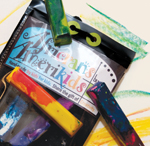 These novelty crayons are produced by Heidi Ziebarth, family and friends. Proceeds help provide care and art supplies to orphaned children in Africa. For order information, contact Christi Ziebarth at africrans@yahoo.com.
These novelty crayons are produced by Heidi Ziebarth, family and friends. Proceeds help provide care and art supplies to orphaned children in Africa. For order information, contact Christi Ziebarth at africrans@yahoo.com.
Kori Brown, Bunker Hill

Kori Brown’s foundation helps families of ill children cover day-to-day expenses. Kori and her mom, Heather Cowan, were at Peyton Manning Children’s Hospital at St. Vincent in Indianapolis last month to help another family whose child was being treated there.
irok a-rollin’: Kori’s ‘irok Foundation’ offers love smoothing paths for families of sick children
The irok Foundation, it might be said, is a mirror-image of its founder, Kori Brown. “irok,” after all, is “Kori” spelled backward.
Kori is the seventh grader from Bunker Hill who has worked tirelessly to raise money for the American Cancer Society despite facing her own chronic illness. She and her family gained national exposure on a January episode of ABC-TV’s “Extreme Makeover: Home Edition.”
While she remains dedicated to moving that mountain of finding a cure for cancer, her foundation works on the flip side. It’s in the trenches, tossing aside the stones hobbling families of sick children by helping them deal with the costs of daily life that get lost amid the daunting episodes of illness, treatment, therapy and bills.
“When you have a child that consumes that much time and that much energy, there’s always things that go by the wayside, and there’s really not a foundation out there to help,” said Heather Cowan, Kori’s mom, who heads up the irok Foundation.
Heather and Kori know those pressures. It was Kori’s mounting medical bills that kept the family from being able to repair its home which was being consumed by mold. That’s when the crew from “Extreme Makeover,” along with hundreds of volunteers from around Indiana, stepped in last October to build the family a new one. From the show, the irok Foundation was born.
“I remember sitting next to a dad one time who was telling me about his car,” Heather said. “His son was dying, he was on the way to the hospital and his car broke down on 465. The nurses pooled their money together and got enough to pay for a cab to pick him up and take him to the hospital.”
The son died two days later, she added, and the man was left with a $1,500 fee to get his towed car out of impound and repaired.
“He didn’t have it. He’d lost his son, and he lost his car,” she said. “And I just thought there’s got to be somebody out there to help these people. They shouldn’t have to worry about their car. They shouldn’t be pulled under water, and they shouldn’t drown because they can’t pay to get their car fixed. That ought to be the last thing that they have to think about.”
The irok Foundation now fills that void. But it was something the family never had dreamed of and no one from the show ever had talked to them about. “We did not know until we shot that final scene that they were starting the irok Foundation for us,” Heather said. “They sprung it on us and literally handed us books and walked away.”
A producer for the show and its star personality, team leader Ty Pennington, came up with the idea after meeting Kori and the family. “They thought Kori was the type of kid who could really turn this into something,” said Heather, “and they wanted to give her a gift that went beyond the house.”
Kori said Pennington asked her one day, “Is there any nickname anybody likes to call you?”
“My mom calls me ‘peanut,’” she told him.
“What is your name spelled backwards?” he continued.
“I was like, ‘i-rok,’” she said, which was something she and her classmates had recently discovered playing around with their names at school.
“He was like, ‘Hmmmmm …,’” Kori said, realizing now Pennington was fishing for a potential name to “sticky note” to the foundation.
CVS Corp., a regular contributor to the show, seeded the foundation with a $50,000 donation.
The roots for all this trace back six years ago when Kori was diagnosed with primary immune deficiency disease. Treatments included weekly infusions of plasma products to help her fight infections. Despite that, she still has needed 18 surgeries, the last one in June, on her sinuses to remove polyps caused by the condition.
During one of her treatments years ago, she met Alyssa Lewandowski, a leukemia patient. The two girls became best friends. Alyssa later went into remission and celebrated her “cured” date in August. But their struggle for the big cure continues. One of Alyssa’s cousins in Wisconsin was diagnosed with leukemia this year.
But driving home after a horrific day hearing Alyssa cry and scream through a spinal tap, Heather and Kori heard a radio ad for Relay for Life. “Do you love someone who has cancer, and do you want to help to find a cure?” the ad said.
“And at 6 years old in kindergarten, she was like, ‘Mom, that’s what I’m going to do. I love her and want there to be a cure,’” Heather recalled.
Two months later, Kori had raised her first $3,500 for cancer research. Kori’s efforts have continued, and she has raised $55,000 for the American Cancer Society. Last year, as a Miami-Cass REMC consumer, she was selected as one of Electric Consumer’s five inaugural “Youth Power and Hope Award” winners.
Heather wasn’t sure she was up for the task when the irok Foundation was left at their feet in late October of last year. “This was a big process,” Heather said. “Once things had settled down a little bit, we realized that we had this opportunity to help other families.”
Heather and Kori sat down and talked about the foundation’s mission. Kori put together a board of directors from adults she knew in the community. The foundation’s non-profit 501(c)3 status was achieved by the time their “Makeover” episode aired early this year. In fact, the first grant was made that Sunday night, Jan. 10.
Since then, the foundation has helped eight other families with things such as mortgage and rent payments and airline tickets to New York for a special medical treatment. The latest was helping a family stay in its home by putting in a bathroom on the ground floor for a son who had suffered paralysis during his chemotherapy.
“The best part by far of the whole ‘Makeover’ experience for me, personally, has been the irok Foundation,” said Heather. “To be able to spend time with these other mothers and to help these families that are in the same situation that we were in for so long has just been huge for me. I was so glad Kori chose that idea.”
Heather said Kori had done much more for her, too. “Kori helped me to realize how important it was to give back. In those first couple of years that she was down in the clinic, I think I was the most self-centered, selfish person ever. All I did was feel sorry for myself and my daughter every day. And it took her getting so active in the American Cancer Society just to help her friend to pull me out of that. I realized how it changed me and how it changed her — physically how much better we are, spiritually how much better we are, and emotionally how much better we are — just because our focus wasn’t on ourselves anymore. That’s a hard lesson to learn from your kid.”
Through all the celebrity, Kori has remained humble and shy speaking to reporters. “Giving back and helping people make me feel really good,” is about all she’ll say. But then again, to flip that around, that really does say it all.
 The irok Foundation supports the families of children with cancer and blood diseases being treated at the Peyton Manning Children’s Hospital at St. Vincent in Indianapolis or Clarian North in Carmel with day-to-day expenses that may not be covered by other foundations or insurance.
The irok Foundation supports the families of children with cancer and blood diseases being treated at the Peyton Manning Children’s Hospital at St. Vincent in Indianapolis or Clarian North in Carmel with day-to-day expenses that may not be covered by other foundations or insurance.

